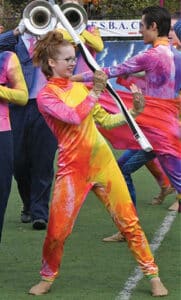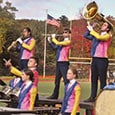Marching Advice from Veteran Judges

With so many bands on the field preparing for marching season, we asked a distinguished panel of judges to share their collected wisdom from decades of experience. They have judged locally and in most cases with Bands of America, US Bands, MAC, Drum Corps International and Drum Corps Associates. All have taught scholastic band. In addition to sharing their perspectives from having watched countless performers, they also offered helpful ideas for continued learning and dialogue between judges, educators, and students.
What are the vital details that lead to success or failure on the field?
 Jeff Smith: Creation, communication and collaboration. The design staff must create a musical and visual presentation that resonates with the staff, members, judges, and the audience. This presentation cannot be created in isolation. The musical and visual concept must be developed simultaneously. Too often, design teams simply select music they like and attempt to squeeze the music into a weak, unrelated visual concept. Conversely, designers must not pair a visual concept with disjunct selections of music that are chosen merely to complete visual moments and lack continuity and line of thought.
Jeff Smith: Creation, communication and collaboration. The design staff must create a musical and visual presentation that resonates with the staff, members, judges, and the audience. This presentation cannot be created in isolation. The musical and visual concept must be developed simultaneously. Too often, design teams simply select music they like and attempt to squeeze the music into a weak, unrelated visual concept. Conversely, designers must not pair a visual concept with disjunct selections of music that are chosen merely to complete visual moments and lack continuity and line of thought.
During the creation process, the design team must communicate with other members of the staff in order to detail, coordinate, and emphasize the performance requirements and musical and visual vocabulary needed to successfully perform the presentation. This communication should continue throughout the teaching and performance process. As with any work of art, revisions and additions are necessary to skillfully communicate the show concept and nuances.
During the season, collaboration between staff, members, judges, and the audience is crucial for the growth and development of the performance. Some staffs act as if their jobs are complete after teaching the music and visual packages. These are just the skeleton of the presentation. Subtleties and performer communication must be continually revised and enhanced and detailed and can only improve when reactions to the show are incorporated into the presentation.
Staff members should avoid watching the performers exclusively and ignoring the audience and judges. The design team should listen to all of the judges’ commentaries and analyze their collective reactions to the performance. The staff can then decide whether to incorporate or dismiss the feedback.
Peter Furnari: Directors should prepare performers to have the ability to demonstrate good technique and training, consistent performance musicality, and understanding of material. The program should demonstrate good musical/visual construction, consistent coordination/use of elements, and an understanding of program direction.
 Debbie Torchia: Make sure members can meet the challenges of the show through scheduled training sessions and skills they already have. These skills/choices are driven by designer intent and require variety with the use of many different methods. Performers require an understanding of the choices needed to accomplish the challenges in the manner required.
Debbie Torchia: Make sure members can meet the challenges of the show through scheduled training sessions and skills they already have. These skills/choices are driven by designer intent and require variety with the use of many different methods. Performers require an understanding of the choices needed to accomplish the challenges in the manner required.
Key areas for training sessions include:
Equipment
Choreography
Field Orientation
Meter and tempo changes
Motion
Role Playing
Form control
The list has endless possibilities from location on the field to the emotions intended by the vehicle.
Failure on the field occurs when performers are not trained in all of the skills needed to accomplish the required choices. Again, the possible ways the show can fail on the field are varied – from asking performers to communicate different emotions using the same skills to not being able to control meter or tempo. In each case, training is what leads to success, and lack of training can lead to disappointment.
 Charley Poole: Program selection is the first and most critical decision an instrumental staff makes. Often groups attempt material outside the reach of students. This may occur with units at both ends of the skill development spectrum. Directors must carefully assess the skill level of the group and also each component section.
Charley Poole: Program selection is the first and most critical decision an instrumental staff makes. Often groups attempt material outside the reach of students. This may occur with units at both ends of the skill development spectrum. Directors must carefully assess the skill level of the group and also each component section.
Ideally the arrangements will fall comfortably within the reach of the members but also provide enough challenge for musical growth. The next step is developing a technique and skill development regimen that supports the program to be performed and leads to successful results. Finally, you have to predict how much members will buy in to the show based on the genre, themes, and challenges presented.
 Jim Vitagliano: I look for strong show planning process being evident or neglected, strong training being displayed or absent, and commitment or lack thereof by the students to the project.
Jim Vitagliano: I look for strong show planning process being evident or neglected, strong training being displayed or absent, and commitment or lack thereof by the students to the project.
What is the difference between a stellar show and one that doesn’t reach its potential?
Debbie Torchia: When the show and performers can express the intent of the designers’ choices in the same way – at the highest level – then a stellar performance happens. All sections of the group have the same understanding and achievement of their individual responsibilities. That doesn’t mean that errors do not occur. Often they can in a great performance, but this does not interfere with the success of the show.
Programs may not reach their potential for several reasons. For example, different sections may reach different levels of achievement, or rehearsals may have neglected some of the group’s responsibilities. Sometimes a group is so perfect but it lacks emotion, or the students were so intense, but I couldn’t follow what they were doing or why.
Peter Furnari: High levels of achievement will elevate a program’s overall presentation. Levels of achievement can be seen in ensembles of any age, size, or competitive class. This excellence can be displayed through the performers’ maturity and musical and visual understanding of the repertoire along with the delivery of a well-constructed, coordinated and balanced composition. A program can’t reach its potential when the how or the what of the program falls short.
Jim Vitagliano: In a great show, foundational training blocks are evident and compositional choices are well thought out and delivered. A weak one includes program choices that do not reflect strong planning and foundational preparation.
Charley Poole: The best programs generally have the following characteristics:
• Consistent thread: This binds the varied musical selections so it is not a disjointed grouping of musical ideas.
• Pacing: There must be methodical pacing of musical and visual concepts that takes the audience on an organized and logical journey.
• Tension and release: To maintain viewer intrigue, the program segments must deliver effects through the application of sufficient tension followed by robust release.
• Staging: This includes the proper placement of ensemble sections and segments to achieve a pleasing and consistent blend and balance.
• Coordination: All aspects of the unit, winds, percussion, guard, and visual design must work in concert to achieve an effective
presentation.
• Creativity: This requires the insertion of novel concepts or variations on accepted norms.
Jeff Smith: An outstanding show incorporates musical and visual variety with consistent coordination between musical and visual concepts. Continuity, line of thought, coloration, subtlety, nuance, contrast, communication, and audience engagement are crucial factors to coordinate all elements of the show. George Zingali had a rule that guided him in designing – that every 20 seconds there needs to be a moment of visual or musical effect leading to a climax of events.
These development elements must be apparent throughout a show to create a coordinated and cohesive presentation. Proper design creates a mutual line of thought shared by musical and visual design to demonstrate direction, flow, intrigue, and emotional ebb and flow rather than a string of isolated, albeit brilliant, moments. Consistent staff and performer collaboration and communication through the final performance will beget a stellar presentation.
What elements do you look for in early season performances?
Charley Poole: With regard to the program, I watch for the framework of a thoughtfully packaged concept supported by the musical offerings and visual representation. With regard to performance, I want to see evidence of solid training on the technical approach to the instruments, uniformity of technique, ensemble listening skills, outline of phrasing concepts, signs of blend, and balance with the sections and the whole.
Jeff Smith: My primary focus for early season performances is potential. It must suggest moments of continuity, line of thought, variety, method of connecting thoughts and coordination of elements. Cleaner performance will come with practice, but it should be secondary to the show’s potential for future growth at this point.
Peter Furnari: I look for performers who understand what is being asked of them and how they deliver it. I simultaneously look at the construction of the program and how it is perceived. The layers of responsibility in the composition and the performers’ display of the skill sets required to deliver the material will often reveal the level of understanding that the designers have in the students’ abilities and the level of understanding the students possess as performers.
Debbie Torchia: I never look for anything in judging. I sit back and allow the program to develop so I can understand the design intent and how they have chosen to communicate it. By doing it this way, I don’t pull apart one aspect or idea from another and can then offer information on what they intended. If it is early in the season, performer accomplishment often will not be at its highest level, but as long as it is recognizable, I can understand what is happening and how well it is being demonstrated. As judges, we understand how to put a program together, so in early season I try to understand what they want to present and how well it comes across. By letting them know when, where, and how this is being accomplished, I offer them recognition and, hopefully, where they need to direct their attention to continue to develop their ideas.
What are the challenges of judging in the short school band season compared to summer DCI?
Peter Furnari: Consistency. Some factors include performer consistency – age, maturity, ability, skill sets. Performance consistency includes level of detail, time invested in rehearsal, and number of performance opportunities. I try to recognize the performance qualities of each ensemble as they are displayed and reward the performances of that day, summer or fall.
Jeff Smith: Making unyielding value judgments of a fall show too early in the season can be a challenge. In the Northeast, units have about ten weeks to perfect and perform their show. All aspects of the show may not come together until the final two weeks.
DCI and DCA judges and staff must avoid judging bands at a level just concluded at drum corps championships. Bands in September have only practiced together for two weeks at most before school started. Once school commences, many bands rehearse just ten hours a week, a single day’s practice for drum corps. Also, unlike marching bands, drum corps often rehearse during the non-competitive season and boast advanced experience, more mature performers, and larger staffs than do high school bands.
Jim Vitagliano: The biggest differences are fewer program views and less time for programs to institute a plan for noticeable progress.
Debbie Torchia: Many DCI performers have been doing this for years, while scholastic performers turn over every four years. This means that the training may vary considerably between the types of skills required. Judges have to understand the differences in philosophy when judging these two types of programs. School bands have time constraints that DCI corps do not, so when offering information, we should take that into account.
Also, judges rarely see a school band more than once a season, so we do not witness their progress over the time. Judges do not always get a chance to critique with band staffs, so many questions we have are not answered. In contrast, DCI corps usually have critiques through most of their season and often corps are seen more than once a season.
Charley Poole: The major differences in adjudication in fall marching band are exposure and judging guideline variations. Compared to DCI adjudication, a judge may only see an ensemble once during the fall. As a result, you must be familiar with scoring guidelines and criteria to provide an accurate ranking and rating. Second, if you judge in a variety of associations, you must be cognizant of the particular scoring and spread guidelines, criteria references, and any other home rule mandates. This requires study prior to each assignment.
Are programs usually underwritten or overwritten? How do you advise teachers whose programs have problems of either variety?
Jim Vitagliano: This varies from group to group. For overwritten programs, conversations about editing are essential. The same goes for underwritten programs, but because of the short time span in marching band, the conversations about underwritten programs may focus more on the achievement of performance excellence. These conversations will happen on different levels based on the experience of the staff, program structure, and knowledge levels
Debbie Torchia: An overwritten production needs clarity of thought (musically/visually), clarity in delivery (what/how), and an elevated level of achievement (write for skill sets). For an underwritten production, directors should review the skill sets of performers, introduce additional colors or textures visually and sonically, determine appropriate opportunities for visual or musical layering, maximize performer involvement, and maximize available resources.
Charley Poole: Overwritten. My advice is to know your players, design/arrange to their skill levels, and maximize your strengths and minimize your weaknesses through design.
Peter Furnari: A majority of compositional issues occur with overwritten visual/musical concepts. Overwritten programs often lack clarity, either because of too many layers in the composition or performers with underdeveloped skills that cannot achieve the desired performance qualities. Clarity of intent becomes cloudy and difficult to read.
 Jeff Smith: I believe programs are more often underwritten. Inexperienced staffs may not trust students to learn the materials, so they place creative restrictions on the visual designer. This is especially apparent in visual passages that lack coordination, continuity, and creativity between visual and musical phrasing. Show design and coordination are difficult to discuss without hurting a unit’s feelings. Judges must reflect on how to address this subject.
Jeff Smith: I believe programs are more often underwritten. Inexperienced staffs may not trust students to learn the materials, so they place creative restrictions on the visual designer. This is especially apparent in visual passages that lack coordination, continuity, and creativity between visual and musical phrasing. Show design and coordination are difficult to discuss without hurting a unit’s feelings. Judges must reflect on how to address this subject.
Tactful honesty is the best policy. Make suggestions that will advance the program. Some ideas may take longer than one season to implement but will lead to substantial benefit for the program. Volunteer to come in for a rehearsal.
Some directors are open to suggestions, while others are defensive and think the judges do not understand their plight even when we have written, designed, taught, teched, and performed for decades. Indeed, those decades of experience may suggest to a youthful instructor that the older judge has antiquated ideas and doesn’t understand their current problems. As judges, we must remain students of the activity and suggest opportunities for growth. Through our judging and critique dialog, we must assure the young staff and directors that we are here to advance the activity and help them grow within it.
How do effective staffs handle critique?
Charley Poole: Some staffs focus on numbers or placement. Effective use of critique time is demonstrated by staffs that secure as much information and clarification from the adjudicator as possible. Solid open-ended questions always seem to provide the most fodder for improvement.
Jim Vitagliano: They understand the criteria used to evaluate their group, they listen to commentary, and make notes that spark conversations about the application of the criteria. They are willing to engage in conversations that not only benefit that group, but broaden a judge’s perspective.
Jeff Smith: They listen! Before entering critique, effective staffs listen to the adjudicators’ sound files or at least the summary at the end of the recording. If there are multiple staff members, they divide up which recordings each caption leader should review. Each staff member decides on one or two areas from the judge’s commentary to discuss thoroughly.
After critique, the staff meets immediately to discuss the adjudicators’ evaluation for their
caption and the implication for the other captions. They develop three areas to work on at the next rehearsal to advance the performance of the show. The staff collaborates prior to that rehearsal and determines methods for addressing those areas.
Peter Furnari: They come in with clear ideas of what their show/presentation is, where it is headed, and how they will reach their ultimate goal. They come in prepared having listened to and taken notes about the recorded commentary. They then formulate questions or answers based on judge commentary and are ready to engage in an interactive level of communication. Directors should come in ready to elevate the overall educational process through meaningful dialogue.
Debbie Torchia: I find the most effective critiques are with staffs that see not only their strengths but also their weaknesses. They know and can discuss what they are doing to improve. These staffs ask about specific moments and understand their show and their intent. They are clear on where they are going, and if I have any questions that I have asked on the file, they explain and answer my questions without attitude or accusations. If judges ask about a moment, it is not coming across as intended. They may discuss how to fix it or not, but the discussion remains professional throughout. It is clear that these staffs are able to see their competitors’ strengths and try to do it better than their competition.
It is a discussion of the program, not an argument about numbers, although it may end with a statement about working up to the number they want. They use their time wisely to gain and share as much information about their program as possible. Over the years, I have learned so much from this kind of critique because they are sharing the new things they are trying and I have the opportunity to watch that process unfold. It has made me a better judge, and I am thankful.
Marching photos courtesy of Jeff Smith and Westbrook (ME) High School Marching Band
Peter Furnari is a percussionist, instructor, and adjudicator with over 40 years of experience as a performer and educator. He joined the Mass Judges Association in 1976 and has been an adjudicator at a national and international level ever since. He has been an active judge for DCI since 1983 and WGI since 2000. In 2009, he was inducted into the Massachusetts Drum Corps and Music Educators Hall of Fame.
Charley Poole has taught, arranged for, and adjudicated marching bands, drum corps, and percussion ensembles throughout the United States, Canada and Japan. He has served as an adjudicator for DCI, DCA, WGI, New England Scholastic Band Association, Maine Band Directors Association, United States Scholastic Band Association, and Bands of America. Recently retired, he was a member of the music faculty of the Everett Public Schools for over 20 years as an instrumental teacher, as well as directing the marching band and percussion ensemble. He is a member of the World Drum Corps, Drum Corps International and Massachusetts Drum Corps Halls of Fame
Jeff Smith has been involved in the marching arts for over forty years as a visual designer, musical arranger, director, show coordinator, caption head, instructor, and judge. He is the Judge Coordinator for the Musical Arts Conference. He taught instrumental music in several public schools over 35 years, and is the visual designer/instructor for the University of New Hampshire (UNH) Wildcat Marching Band and designs for high school bands in Connecticut, New Hampshire, and Maine.
Debbie Torchia has been an instructor and designer of Drum Corps, Winter Guards, and Marching Bands, including The Guardsmen Drum and Bugle Corps, St Joseph’s Grenadiers Winter Guard, Triton Regional High School Band, Melrose High School Band, and The Boston College Eagles Marching Band, among others. She has a long history of judging locally and nationally for several associations, including Eastern Massachusetts, CYO, Massa-chusetts Instrumental and Choral Conductors Association, WGI, Bands of America, Western Band Association, WGASC, and DCI.
Jim Vitagliano served as the President of Massachusetts Judges Association. from 2006 through 2019. Currently, he sits on the Board of Directors as Past President and Director of Communications. He served for several years on the WGI Board of Directors. He is chief judge of the Maine Band Directors Association. Since 1988 he has been active as a show designer, technician and consultant for a number of winter guards, marching bands, indoor percussion groups and drum corps in addition to his work as a judge. He is a member of the Massachusetts Drum Corps Hall of Fame.





